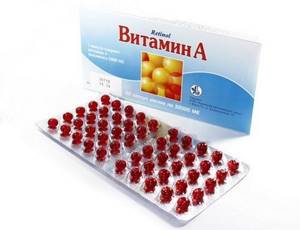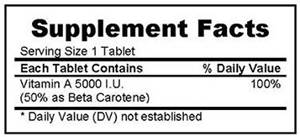Many people have heard about the benefits of fat-soluble vitamins A and E, but not everyone can answer with confidence why tocopherol and retinol should be taken in pairs, what are the indications for their use, how to properly take vitamins A and E in capsules... All these questions will be answered today "Popular about health."
Retinol - health benefits
Retinol is a fat-soluble vitamin. In the pharmaceutical industry it is available in capsules. How is this substance useful?
Retinol plays a huge role in the body. It increases resistance to infectious diseases, skin infections, promotes better skin regeneration in case of burns, strengthens nails and hair, bone tissue, and improves visual acuity.
Indications for use
Who should take vitamin A periodically? What health problems indicate its deficiency in the body? Indications for use:
1. Rickets. 2. Skin rashes, skin pigmentation. 3. Brittle nails, dull hair, hair loss. 4. Frequent colds, respiratory diseases. 5. Vitamin deficiencies. 6. Problems with the musculoskeletal system. 7. Loss of twilight vision. 8. Migraines. 9. Weakness. 10. Diabetes mellitus.
In fact, this element is a participant in many processes occurring in the body. Therefore, it is recommended for all people to take it periodically. But how to do this? What is the dosage regimen?
How to take vitamin A capsules correctly
?
The main thing you need to know is that retinol is always taken in pairs with tocopherol. This substance protects retinol from oxidation and promotes its better absorption. The second rule of use is that you must not exceed the dose. An excess of a substance is dangerous, as is its deficiency.
If you are not sure whether you need to take a course of retinol, consult your doctor. It will determine whether there is a need for this substance in your body. If necessary, the doctor will prescribe a dosage regimen and indicate what dosage to follow.
General consumption rates are indicated in the instructions for the drug:
1. Children are prescribed 350 mcg of the substance (10,000 IU). 2. Teenagers – 600 mcg (20,000 IU). 3. Adults – 900 mcg (30,000 IU).
Vitamin A is most often sold in capsules. Each of them contains the average daily intake of the substance for an adult. To maintain immunity and beauty of skin and hair, it is recommended to take no more than one unit of vitamin per day in capsules. This is how to take vitamin A correctly. In addition, the drug should be taken after meals (every quarter of an hour) once a day, swallowing the capsule and washing it down with water. The dosage is prescribed by the doctor, as well as the duration of the course of treatment. According to the instructions, the intake standards are as follows:
1. For severe vitamin deficiency, eye and skin diseases - from 33,000 to 100,000 IU per day. 2. For preventive purposes – 33,000 IU per day.
The maximum daily dose for adults is 100,000 IU. It is important to know that vitamin A is removed from the body slowly, it tends to accumulate, so exceeding doses and drinking it unnecessarily is dangerous.
Indications for use of tocopherol
Tocopherol is a substance accompanying retinol. When paired, these components have a stronger effect on the ability of tissues to regenerate, enhance the body’s immune responses, and have a beneficial effect on overall tone. It is shown when:
1. Menopause. 2. Planning pregnancy. 3. Dermatoses. 4. Sexual dysfunctions in men. 5. Epilepsy. 6. Myopathies. 7. Muscular dystrophy. 8. Overwork.
Tocopherol is a powerful antioxidant and can be prescribed for general weakening of nonspecific immunity as a supportive agent.
How to take vitamin E correctly
?
You cannot drink tocopherol for a long time without a doctor’s prescription. High doses of the drug can contribute to the development of vitamin deficiency A. Capsules with the substance are available in various dosages - 100 mg, 200 mg, 400 mg.
The average daily dose of this substance for adults is 100 mg. In case of acute vitamin deficiency, the dose is increased to 200 mg per day. The average course of therapy is 4 weeks. If necessary, after a three-month break, treatment is repeated. The capsule is swallowed with water after meals.
This drug is contraindicated for children under 12 years of age. People with acute myocardial infarction and cardiosclerosis should not take tocopherol. An overdose of tocopherol is harmful to health.
Aevit is a preparation containing both vitamins
Since it is correct to take vitamins A and E in pairs, it is advisable to use preparations containing two substances in one capsule. For example, "Aevit". Each pill of this drug contains 100 mg of tocopherol and 100,000 IU of retinol. You should take the medicine one capsule daily 15 minutes after meals.
Understanding how to properly take any vitamin supplement is very important. Some people, without the knowledge of a doctor, stuff themselves with various complexes, not understanding the danger of an overdose. If there is no shortage of these components in the body, then you should not consume them, as they, having accumulated in the body, lead to health problems. For example, an excess of tocopherol in the body threatens the formation of blood clots, and an excess of retinol leads to poor vision, brittle nails, cracks in the skin, and causes pain in the bones. Who needs such problems?
Vitamin A is a fat-soluble vitamin (retinol) that promotes normal growth and development of the body. It improves the immune system and promotes rapid regeneration of the skin epithelium. Vitamin A rejuvenates the body, protects the skin from aging and ultraviolet rays. Retinol promotes the production of glycogen in the heart, liver, and muscles. It has a beneficial effect on the visual system, the activity of the thyroid gland, sweat and sebaceous glands.
It is known that everything useful should be in moderation. Let's look at how to take vitamin A so as not to harm your body.
Retinol Activity Equivalents (RAEs)
Vitamin A can be obtained from food or in the form of dietary supplements. However, it is important to understand that while animal-based vitamin A is efficiently absorbed and converted into active forms of vitamin A, carotenoids such as beta-carotene are less easily absorbed and absorbed. Moreover, the efficiency of converting provitamin A into retinol varies greatly and depends on factors such as food source, preparation method, and the individual's digestive system.
The latest accepted international standards for measuring vitamin A activity are retinol activity equivalents (RAE). It has been found that 2 mcg of beta-carotene in oil as a dietary supplement can be converted by the body to 1 mcg of retinol, resulting in a RAE ratio of 2:1. To provide 1 mcg of retinol, you need 12 mcg of beta-carotene from food, resulting in a 12:1 ratio. Other provitamin A carotenoids in food are much less absorbed than beta-carotene, resulting in a RAE ratio of 24:1.
Table 1. Retinol activity equivalents (RAEs) for provitamin A carotenoids
Indications and contraindications
Vitamin-mineral complexes are indicated in the following cases:
Contraindications:
Recommended intake of vitamin A
The Vitamin A Dietary Recommendations (RDA) were revised by the Food and Nutrition Board of the US Institute of Medicine in 2001. The RDA is the recommended amount of vitamin A required by almost the entire population to ensure adequate vitamin A stores in the liver, maintain normal reproductive function, gene expression, immunity, and vision.

Table 2. Recommended Daily Allowances for Vitamin A (RDA)
*Adequate Intake (AI), equivalent to the average vitamin A intake of healthy breastfed infants.
Permissible upper level of consumption
Upper levels apply to retinol or its ester forms such as retinyl palmitate. No upper tolerable levels have been established for beta-carotene and other carotenoids.

Table 3. Vitamin A Ultimate Intake Levels (UL)
Vitamin A capsules may contain a mixture of retinol and beta-carotene. In such cases, only the retinol content of the supplement should be considered to determine whether a given vitamin A intake exceeds the upper limit.
INDICATIONS FOR USE
In therapy
vitamin A is used in therapy for the prevention and treatment of vitamin A deficiency and hypovitaminosis caused by a lack of retinol in food (keratomalacia, xerophthalmia, phrynoderma, etc.); for inflammatory and erosive-ulcerative diseases of the intestines, chronic gastritis, gastric and duodenal ulcers, acute epidemic hepatitis, cirrhosis of the liver, kidney stones, oxaluria, pyelitis, tracheitis, bronchitis, nasopharyngeal catarrh.
As a means of activating oxidative processes and increasing the body's overall resistance, vitamin A is used for infectious diseases.
Local vitamin A preparations are prescribed to activate the processes of healing and tissue regeneration, for the treatment of wounds, ulcers, burns, and frostbite.
In dermatology,
taking into account the fact that retinol helps reduce the severity of inflammatory phenomena and normalizes skin functions, and also taking into account the reduced content of vitamin A in the skin in some chronic dermatoses, vitamin A is used for dry skin (xeroderma), ichthyosis, psoriasis, parapsoriasis, keratoderma, follicular keratosis, dyskeratoses (Darier's dyskeratosis vegetans, etc.), seborrheic eczema, asbestos-like lichen, prurigo, alopecia, atopic dermatitis, neurodermatitis, acne, chronic pyoderma, furunculosis, skin tuberculosis, urticaria, chills, inflammatory changes in the oral mucosa (leukoplak iya) and larynx, seizures, with hyperpigmentation, growth disorders and premature graying of hair, with nail diseases.
Units of change: IU and mcg RAE
On nutritional supplement labels, you may find vitamin A dosages listed in IU or mcg (RAE). Unlike RAE, vitamin A IU does not reflect the bioavailability of vitamin A from various dietary sources.
Therefore, starting in January 2020, the U.S. Food and Drug Administration (FDA) required manufacturers to use new labels that provide information about the amount of vitamin A in mcg RAE. RAE (retinol activity equivalent) is the biological activity equivalent of vitamin A, which is converted by the body into retinol. Companies with annual sales of less than $10 million may continue to use the old vitamin A international unit (IU) labels until January 2021.
Converting RAE to IU, and vice versa, is only possible if the source of vitamin A is known. To convert IU and RAE, use the following formula:
- 1 IU retinol = 0.3 mcg RAE
- 1 IU beta-carotene from supplements = 0.15 mcg RAE
- 1 IU beta-carotene from food = 0.05 mcg RAE
- 1 IU alpha-carotene or beta-cryptoxanthin from food = 0.025 mcg RAE
For example, a daily value of 900 mcg RAE for adolescent and adult men is equivalent to 3,000 IU if the food or supplement source is retinol. The same 900 mcg of RAE would be equivalent to 6,000 IU if the source of beta-carotene were dietary supplements. Therefore, a diet containing 900 mcg RAE provides between 3,000 and 36,000 IU of vitamin A, depending on the foods or supplements consumed.
Supplements
Today, there are a large number of different supplements that help cover vitamin A deficiency. Most often, it is available in the form of complex supplements in combination with other vitamins. You should take additional retinol 2 times a day: morning and evening. It is important that it enters the body at least 10 minutes after eating. It is after this time that the body begins to secrete substances that will help its rapid absorption. It should be remembered that 50% of this substance should come from regular food.
It should also be noted that additional intake of vitamin A is not compatible with the consumption of alcoholic beverages, since such a combination can provoke the occurrence of certain liver diseases.
When choosing an additional source of vitamin A, pay attention to the amount of retinol in the preparation. Supplements may vary, and each may be helpful for specific conditions.

Vitamin A is a fat-soluble vitamin that promotes normal development and growth of the body and metabolism.
The use of vitamin A reduces inflammation and normalizes the change in layers of the epidermis.
Health Risks from Excessive Vitamin A Consumption
Because vitamin A is fat-soluble, the body stores excess vitamin A, primarily in the liver. It is important to know that excess vitamin A can cause toxicity in the body, known as vitamin A hypervitaminosis.
Manifestations of hypervitaminosis A depend on the amount and duration of intake. Chronic intake of excess vitamin A leads to increased intracranial pressure (pseudotumor cerebri), dizziness, nausea, headaches, skin irritation, joint and bone pain, coma, and even death. Although hypervitaminosis A can be caused by excessive food intake, the condition is usually the result of consuming too much vitamin A capsules. After stopping vitamin A intake, its content in tissues decreases for a long time, and the resulting liver damage may be irreversible.
Pregnant women should strictly adhere to the recommended intake of vitamin A and coordinate its intake with their doctor. Consumption of vitamin A capsules exceeding the permissible limit and treatment with certain topical ointments (eg, Retinoic ointment) may cause birth defects. These birth defects may include malformations of the eye, skull, lungs, and heart.
Taking large amounts of beta-carotene and other carotenoids does not cause serious side effects ( ). The fact is that beta-carotene is converted into active vitamin A only as needed, so there is no risk of overdose.
Unlike vitamin A, beta-carotene does not interfere with embryonic development and is not toxic (). Even large supplemental doses (20,000–30,000 mcg/day) of beta-carotene over the long term did not cause toxicity in the body.
The most significant effect of long-term excess beta-carotene is carotenoderma, a harmless condition in which the skin turns yellow-orange ( ). This condition resolves after stopping beta-carotene intake.
However, people who smoke are advised to avoid taking beta-carotene supplements. People who smoke, and perhaps those who used to smoke, should avoid beta-carotene supplements and multivitamins that contain more than 100% of their daily value of vitamin A. This is because research has linked high doses of these nutrients to increased risk of lung cancer in smokers.
What diseases does a lack of vitamin C in the body lead to?
Vitamin C deficiency can cause serious diseases, including:
- Scurvy. Main symptoms: bleeding and swelling of the gums, dryness and petechiae on the skin, loosening and loss of teeth, perversion of taste, nosebleeds. To treat the disease, ascorbic acid tablets are prescribed, and it is also recommended to follow a diet. The dosage of vitamin C for various diseases can be up to 500 mg per day. The physiological requirement is from 40 to 110 mg per day.
- Follicular keratosis. The skin on the back of the shoulders, thighs and buttocks is primarily affected. It becomes uneven, rough, rough.
- Hair deformation. They become curved or spiral shaped, resembling a corkscrew. As hypovitaminosis progresses, they begin to fall out. To cope with the problem, it is necessary to normalize the intake of vitamin C in the body.
- Perifollicular hemorrhage (appearance of bright red dots in the area of the hair follicles). This disorder indicates a severe deficiency of vitamin C. However, with adequate therapy, the patient’s condition normalizes within 14 days from its start.
- Changes in the shape and structure of the nails (koilonychia). They become concave, and longitudinal red lines and spots appear on them.
- Dry skin, thinning. This is due to the fact that vitamin C is directly involved in the production of collagen, which is responsible for the elasticity of the dermis.
- Fragility of blood vessels. Small capillaries are affected first. Due to their rapid damage, bruises easily form on the human body. Bruising appears even if it is not preceded by injury.
- Slow wound healing. In the course of research, it was found that people with chronic leg ulcers always have reduced levels of vitamin C. In severe cases, a lack of ascorbic acid can be the root cause of the appearance of ulcers.
- Joint diseases. Sometimes they are so severe that the person develops lameness. The pain intensifies due to weakness of the blood vessels and swelling of the tissues.
- Weakness of bone tissue. It has been experimentally established that vitamin C is of enormous importance for bone formation. If there is little of it, then the rate of bone loss increases. Children's bone tissue is especially sensitive to a lack of ascorbic acid.
- Bleeding gums, tooth loss. With a mild deficiency, the gums swell, become swollen, and are easily damaged. As vitamin deficiency progresses, they become even more inflamed, become purple in color, and may become covered with purulent ulcers. If treatment is not started in time, dentin weakens, teeth become loose and fall out.
- Immunodeficiency. Numerous studies have found that vitamin C accumulates in immune cells and helps them resist harmful flora. If there is a lack of it, the protective forces weaken, and the risk of developing pneumonia and other serious diseases that end in death increases.
- Iron-deficiency anemia. Its main symptoms: pale skin, increased fatigue, dryness and hair loss, headache, koilonychia.
- Apathy , low mood, lack of energy.
- Obesity not associated with overeating and other obvious factors. It has been found that vitamin C deficiency leads to excess fat accumulation in the waist and abdomen.
- Chronic inflammation. Vitamin C is a well-known antioxidant. If there is not enough of it, then the cells are unable to withstand oxidative stress, become inflamed and destroyed. This, in turn, leads to the development of serious diseases and increases the risk of developing cardiovascular pathologies. One study found that adults with chronic ascorbic acid deficiency (15 years or older) had a 40% increased risk of developing heart failure.
[Video] Facts about vitamin C that you definitely didn’t know:
The importance of vitamin C in nutrition
Vitamin C takes part in detoxification processes in hepatocytes, together with cytochrome P450. Ascorbic acid neutralizes the superoxide radical, converting it into hydrogen peroxide, and also restores vitamin E and ubiquinone.
Without vitamin C, the normal formation of the immune system is impossible, since it is one of the leading stimulators of interferons. Its entry into the body ensures normal absorption of iron by the walls of the small intestine.
Vitamin C prevents hemoglobin glycation and prevents glucose from being transformed into sorbitol. Simply put, it prevents spikes in blood sugar levels.
There is evidence that ascorbic acid resists premature wear of neurons and is a means of preventing senile dementia and Alzheimer's disease. It is believed that consuming high doses of vitamin C as a dietary supplement does not provide the desired benefits. It is much more important to simply avoid chronic deficiency of this substance.
Vitamin A deficiency
Vitamin A deficiency is common in many developing countries. According to the World Health Organization, 190 million preschool children and 19 million pregnant women worldwide have serum retinol concentrations below normal. In these countries, low vitamin A intake has the greatest impact on health, especially during periods of high nutrient need, such as infancy, childhood, pregnancy and breastfeeding.
In developing countries, vitamin A deficiency usually begins in infancy, when infants do not receive enough colostrum or breast milk. Chronic diarrhea also leads to excessive loss of vitamin A in young children, and vitamin A deficiency increases the risk of diarrhea. The most common sign of vitamin A deficiency in young children and pregnant women is xerophthalmia. One of the early signs of xerophthalmia is night blindness, or the inability to see in low light or darkness. Vitamin A deficiency is one of the leading causes of preventable blindness in children.
Serum retinol concentration is a common method used to assess vitamin A deficiency. Low plasma retinol levels are the basis for diagnosing acute vitamin A deficiency in the body. However, normal blood levels of vitamin A do not reflect total vitamin A levels in the body, since serum retinol does not decrease until liver stores become dangerously low. Therefore, other biochemical methods have been developed that can assess the reserve amount of vitamin A in the liver. These include dose-response tests, in which plasma retinol levels are measured before and after administration of a small amount of vitamin A. An increase in plasma retinol levels of 20% or more indicates a vitamin A deficiency in the body.
Benefits of Vitamin C
Health Benefits of Vitamin C:
- Vitamin C is a good antioxidant. It neutralizes free radicals and prevents the development of chronic diseases. A number of studies have shown that regular intake of ascorbic acid into the body helps increase the level of antioxidants in the blood by 30%.
- Vitamin C is effective for hypertension. Analysis of a number of studies suggests that with its regular intake into the body, a person’s systolic and diastolic pressure becomes lower. [1]
- Vitamin C is a means to prevent heart and vascular diseases. Based on an analysis of 9 studies involving nearly 300,000 people, 700 mg of it reduces the risk of cardiovascular disease by 25% in people who get it from food rather than from supplements. In another 13 studies, scientists found that ascorbic acid reduced bad cholesterol levels by almost 8 mg/l and triglycerides by 20.1 mg/l. [2]
- Vitamin C significantly reduces the risk of gout. Taking it helps reduce uric acid levels, which means protecting against new attacks of the disease. This was proven in scientific studies involving almost 50,000 healthy men. Those who regularly received vitamin C had a 44% reduction in the risk of developing gout. [3]
- Vitamin C prevents anemia. This is possible due to the fact that ascorbic acid promotes better absorption of iron in the intestines. Simply consuming 100 mg of vitamin C with a meal containing iron improves iron absorption by 67%. This property of vitamin C is especially important for people who adhere to vegetarianism.
- Vitamin C strengthens the immune system , as it stimulates the activity of leukocytes to fight harmful flora, and also increases the resistance of the skin. Numerous studies have proven that ascorbic acid accelerates wound regeneration. There is evidence that people suffering from pneumonia have lower levels of vitamin C, and its introduction into the treatment of pneumonia speeds up recovery.
- Vitamin C prevents the development of senile dementia due to its powerful antioxidant abilities. It has been shown to prevent the development of dementia when sufficiently supplied through food or dietary supplements.
Vitamin C for colds: how does it protect us from viruses?
The effect of vitamin C on viral diseases has been studied in numerous studies. An analysis of 29 scientific studies with a total of 11,306 participants concluded that adding 200 mg of ascorbic acid or more does not reduce the likelihood of catching a cold. However, not everything is so simple. If there are other conclusions that scientists have come to. In particular, taking vitamin C can achieve the following effects: [4]
- Reducing the severity of a cold.
- Reduction in disease duration by 8% in adults and 14% in children.
Other studies have shown the effectiveness of 6-8 g of ascorbic acid per day for sick adults and 1-2 g for children.
An even more pronounced effect was obtained among marathon runners, soldiers and skiers training in the Arctic. In them, vitamin C reduced the duration of colds by 50%.
Therefore, it was concluded that the substance exhibits increased therapeutic and antioxidant activity in individuals under the influence of physical stress.
Vitamin C for immunity
Vitamin C affects different parts of the immune system, making it stronger and stronger. Main directions of “work”:
- Stimulation of leukocyte production. It is these blood cells that are the main fighters against infection.
- Improving the ability of leukocytes to resist harmful flora and free radicals. As a result, all body cells are better protected.
- Strengthening the skin barrier.
- Acceleration of tissue repair process.
Vitamin C deficiency negatively affects the immune system. For example, it was found that in patients with pneumonia its level is reduced, and such patients also recover longer and worse.
Vitamin C for anemia
Vitamin C has been proven to improve iron absorption. It transforms it into a form that is better absorbed by the body. Therefore, for anemia, it is so important to include in the diet foods rich not only in iron, but also in ascorbic acid, for example, leafy vegetables, strawberries, and bell peppers.
Participants in one study took 100 mg of vitamin C with meals. As a result, their iron absorption process increased by 67%. These scientific findings are especially valuable for vegetarians, whose main problem is anemia. [5]
Interesting Scientific Facts About Vitamin C
Interesting scientifically proven facts about vitamin C:
- Vitamin C combined with Doxycycline effectively fights cancer stem cells. Such conclusions were made by scientists from the University of Salford (Britain). Practicing professor M. Lisanti explains this by the fact that during chemotherapy, some cancer cells die because they cannot find nutrition, while others adapt to changing conditions and find auxiliary substances to maintain their vital functions. The combination of Doxycycline and ascorbic acid prevents them from getting energy from new sources. As a result, the surviving cells die of starvation. The undoubted advantage of this therapy is that both drugs do not have such a pronounced toxic effect on the body as classical chemotherapy.
- Intravenous vitamin C prevents atrial fibrillation after heart surgery. When receiving ascorbic acid, this complication developed less frequently by 44%, and patients were able to quickly leave the walls of the medical institution and return home. These conclusions were made by scientists from the University of Helsinki.
- Vitamin C can shorten the treatment period for tuberculosis if complex therapy is carried out. The experiment was carried out on rodents, and the findings were published in the journal Antimicrobial Agents and Chemotherapy. Scientists practiced 3 methods of treatment: only anti-tuberculosis drugs, only vitamin C, and a combination of these drugs. As a single drug, ascorbic acid did not allow for recovery or improvement, but in combination with Isoniazid and Rifampicin, the condition of the experimental mice quickly improved, and the affected tissues were restored. Their 100% cleansing of tuberculin bacillus occurred in just a week.
- Vitamin C helps you lose weight without exhausting physical training. This stunning conclusion was announced at the 14th International Conference on Endothelin. It turned out that ascorbic acid has the ability to reduce the activity of the ET-1 protein, which increases the risk of developing cardiovascular pathologies by stimulating the narrowing of blood collaterals. It has been established that, provided that vitamin C is regularly supplied in an amount of 500 mg, it reduces the activity of ET-1. Moreover, this effect is similar in strength to walking in the fresh air.
Use in folk medicine
Traditional medicine considers vitamin C as an anti-cold remedy. To prepare a medicinal drink that helps with respiratory viral diseases, you will need:
- Boiled water – 1.5 l.
- Table salt – 1 tbsp. l.
- Juice of 1 lemon.
- Ascorbic acid – 1 g.
You need to drink this drink within 1.5-2 hours. Teas with raspberries, lingonberries, and cranberries are no less beneficial.
Traditional healers call vitamin C an effective preventative against cancer. For this purpose, it is recommended to eat tomatoes seasoned with olive oil with the addition of garlic, dill and parsley.
To combat insomnia, to relieve nervous tension, as well as to relieve inflammation and pain from infectious diseases, traditional medicine recommends taking oregano as a source of vitamin C.
Vitamin A capsules

The main forms of vitamin A in supplements are retinyl palmitate and retinyl acetate. Beta-carotene capsules are also a source of vitamin A. Some supplements may contain a combination of retinol and beta-carotene. In this case, the percentage of each source should be listed in the “Supplement Facts” section on the back of the label (Figure 1).
Some multivitamin supplements available in the US contain up to 5,000 IU of retinyl palmitate, which corresponds to 1,500 mcg RAE, which is significantly higher than the current daily intake for vitamin A. This is because the daily values (DV) used by the FDA US Drug Administration (FDA) labeling guidelines for supplements are based on the outdated RDA standards established back in 1968.
Because a retinol intake of 5,000 IU/day (1,500 mcg RAE) may be associated with an increased risk of osteoporosis in older adults, some companies have reduced the retinol content of their multivitamin supplements to 2,500 IU (750 mcg RAE).
Beta carotene
Now Foods, Natural Beta Carotene, 25,000 IU, 180 Capsules
Each capsule contains: 3,750 mcg of beta-carotene derived from D. salina
Dunaliella salina is a species of green microalgae that grows in salty seawater. Known for its antioxidant activity due to its ability to synthesize large amounts of carotenoids, which are actively used in cosmetics and food supplements.
Buy at a discount
Solgar, Beta Carotene Dry, 3,000 mcg, 250 Tablets
One capsule contains: 3000 mcg of beta-carotene.
This vitamin A capsule is oil-free and suitable for those who have difficulty digesting oil-based supplements.
The complex contains vitamin A in the form of beta-carotene and a mixture of other carotenoids (alpha and beta carotene, lutein, zeaxanthin, cryptoxanthin). Suitable for vegans.
Buy at a discount
California Gold Nutrition, AstaCartenoid, Lutein, Lycopene, Astaxanthin Complex, 30 Capsules
I really like this complex, which has an iTested quality certificate. One capsule provides your daily value of beta-carotene, enriched with a blend of other antioxidant carotenoids derived from calendula flowers, tomatoes and algae.
One capsule contains: 1800 mcg of beta-carotene, which is equivalent to 900 mcg of RAE retinol and corresponds to 100% of the daily value.
Lutein and zeaxanthin from calendula flowers. Lutein and zeaxanthin are concentrated in the macula and lens of the eye, where they protect eye tissue from oxidative stress.
Alpha, beta and gamma carotene. The body converts these carotenoids into vitamin A, which is essential for maintaining night vision.
Lycopene from tomatoes. Lycopene is an antioxidant that protects against damage caused by reactive oxygen species.
Phycocyanin and astaxanthin are antioxidant carotenoids found in algae that protect lipids from peroxidation.
Buy at a discount
Vitamin A for children
Cod liver oil is a natural source of vitamin A, as well as other nutrients such as omega-3 fatty acids and vitamin D-3. Therefore, some people prefer to take cod liver oil as a preventative measure rather than a separate vitamin A supplement.
However, keep in mind that cod liver oil does not contain as many vitamins as a dedicated vitamin A supplement. For this reason, it may be more suitable for people who are not vitamin A deficient and therefore do not need high doses of supplements.
The Vitamin A content in these supplements corresponds to children's standards.
Nordic Naturals, Arctic Cod Liver Oil, Lemon, 237 ml
Nordic Naturals is one of the most trusted brands in the nutritional supplement industry.
This oil is made from Atlantic cod and is third party tested for purity. The oil contains just three ingredients - cod liver oil (a rich source of omega-3), vitamin A and rosemary extract, which serves as a natural preservative.
One serving contains 13% of the daily value of vitamin A for children ages 1 to 3 years. Or 4% for adults and children over 4 years old.
Buy at a discount
Carlson Labs, Wild Norwegian Cod Liver Oil, Natural Lemon Flavor, 250 ml
Carlson is another trusted source of high-quality omega-3 fish oil supplements and wild Norwegian cod liver oil.
Their cod liver oil is certified by the International Fish Oil Standards (IFOS), the certification body for fish oil products that helps ensure the quality, purity and safety of the products.
In addition to vitamin D, vitamin E, and omega-3 fats, this supplement provides 28% of the daily value of vitamin A per serving.
Buy at a discount
Oslomega, Norwegian series, cod liver oil for children, natural strawberry flavor, 200 ml
Cod liver oil contains naturally occurring vitamins A and D and omega-3 fatty acids including EPA and DHA. The supplement supports the development of the brain, nervous system and vision in children.
Manufactured in a current Good Manufacturing Practices (cGMP) compliant facility with quality assurance testing.
Buy at a discount
Vitamins to take before lunch
Vitamin B1:
activates metabolism and supports the nervous system.
Vitamin B12:
participates in the maturation of new red blood cells and the functioning of the nervous system; helps you relax in stressful situations.
Iron:
Helps blood carry oxygen and supports immunity.
Q10:
prevents heart attacks and improves sexual function.
Vitamin C:
participates in the production of collagen and regeneration of mucous membranes; boosts the immune system.
Each of these components has a stimulating effect on the human body, so taking them in the morning before lunch will keep you in good shape for the rest of the day.
On a note:
vitamin C (ascorbic acid) is involved in the absorption of iron by the body, so doctors recommend taking these two supplements at the same time or enriching the menu with one component, taking the second in tablets.
Where is the best place to buy vitamin A or beta-carotene?
- The iHerb website offers you products from world famous brands, which are sold in many pharmacies and retail stores.
- Guarantee of freshness and quality of products
- iHerb prices are 30–50% lower than pharmacy prices and may not differ from wholesale ones, which is due to direct deliveries and the absence of intermediaries.
- Orders are delivered to any corner of the world.
- 24/7 support via chat or contact details on the website.
How to get the most out of every iHerb purchase?
- Get a discount on all orders using promo code NIH688. To do this, when placing an order, follow the link or enter the code NIH688 manually.
- Additional 10% discount on all orders over $60. To activate an additional 10% discount on all orders over $60, click on code VALUE60.
Research
- https://pubmed.ncbi.nlm.nih.gov/20980645/
- Johnson EJ, Russell RM. Beta-Carotene. In: Coates PM, Betz JM, Blackman MR, et al., eds. Encyclopedia of Dietary Supplements. 2nd ed. London and New York: Informa Healthcare; 2010:115-20.
- https://ods.od.nih.gov/factsheets/VitaminA-HealthProfessional/

READ MORE









